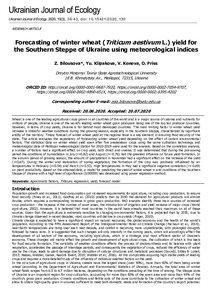Please use this identifier to cite or link to this item:
http://elar.tsatu.edu.ua/handle/123456789/12845Full metadata record
| DC Field | Value | Language |
|---|---|---|
| dc.contributor.author | Bilousova, Zoia | - |
| dc.contributor.author | Білоусова, Зоя Володимирівна | - |
| dc.contributor.author | Белоусова, Зоя Владимировна | - |
| dc.contributor.author | Klipakova, Yuliia | - |
| dc.contributor.author | Кліпакова, Юлія Олександрівна | - |
| dc.contributor.author | Клипакова, Юлия Александровна | - |
| dc.contributor.author | Kenieva, Viktoriia | - |
| dc.contributor.author | Кенєва, Вікторія Анатоліївна | - |
| dc.contributor.author | Кенева, Виктория Анатольевна | - |
| dc.contributor.author | Priss, Olesia | - |
| dc.contributor.author | Прісс, Олеся Петрівна | - |
| dc.contributor.author | Присс, Олеся Петровна | - |
| dc.date.accessioned | 2021-01-22T11:27:14Z | - |
| dc.date.available | 2021-01-22T11:27:14Z | - |
| dc.date.issued | 2020 | - |
| dc.identifier.uri | http://elar.tsatu.edu.ua/handle/123456789/12845 | - |
| dc.description.abstract | Wheat is one of the leading agricultural crops grown in all countries of the world and is a major source of calories and nutrients for millions of people. Ukraine is one of the world's leading winter wheat grain producers being one of the top ten producer countries. However, in terms of crop yields, Ukraine is far behind most developed countries. The main limiting factor in winter wheat yield increase is stressful weather conditions during the growing season, especially in the Southern Steppe, characterized by significant aridity of the territory. Timely forecast of winter wheat yield at the regional level is a key element in ensuring food security of the state. The article evaluates the expediency of forecasting winter wheat yield depending on the effect of certain environmental factors. The statistical data on winter wheat yield sown after five predecessor crops using the same cultivation technology and meteorological data of Melitopol meteorological station for 2010-2019 were used for the analysis. Based on the correlation analysis, a number of factors had a significant effect on crop yield, both direct and inverse. It was determined that during the pre-sowing period the conditions of humectation in July (r=0.82) and August (r=-0.76) had the greatest influence on future yield formation. In the autumn period of growing season, the amount of precipitation in November had a significant effect on the increase of the yield (r=0.67). During the winter and restoration of spring vegetation, the formation of the crop was positively influenced by air temperatures in February (r=0.54) and March (r=0.53). High temperatures in May had a significant negative correlation (r=-0.69) on plant productivity. Based on the obtained data, a model for predicting the yield of winter wheat in arid conditions of the Southern Steppe of Ukraine with a high level of significance (0.00009) was developed using power regression method. | uk |
| dc.language.iso | en | uk |
| dc.relation.ispartofseries | Ukrainian Journal of Ecology;10(3) (P. 36-43) | - |
| dc.subject | Agroclimatic factors | uk |
| dc.subject | Triticum | uk |
| dc.subject | regression | uk |
| dc.subject | yield | uk |
| dc.subject | forecast model | uk |
| dc.title | Forecasting of winter wheat (Triticum aestivum L.) yield for the Southern Steppe of Ukraine using meteorological indices | uk |
| dc.type | Article | uk |
| Appears in Collections: | Кафедра Рослинництва та садівництва ім. професора В.В. Калитки | |
Files in This Item:
| File | Description | Size | Format | |
|---|---|---|---|---|
| 9. forecasting-of-winter-wheat-triticum-aestivum-l-yield-for-the-southern-steppe-of-ukraine-using-meteorological-indices.pdf | 944.69 kB | Adobe PDF |  View/Open |
Show simple item record
CORE Recommender
???jsp.display-item.check???
Items in DSpace are protected by copyright, with all rights reserved, unless otherwise indicated.
